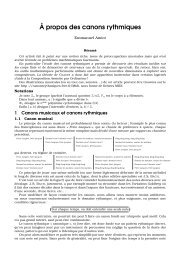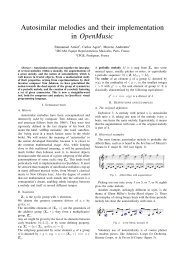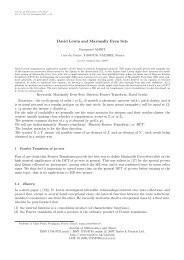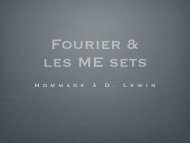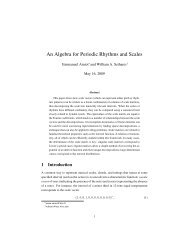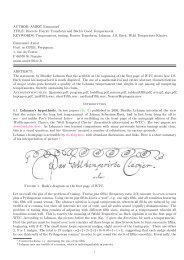Emmanuel Amiot Modèles algébriques et algorithmes pour la ...
Emmanuel Amiot Modèles algébriques et algorithmes pour la ...
Emmanuel Amiot Modèles algébriques et algorithmes pour la ...
Create successful ePaper yourself
Turn your PDF publications into a flip-book with our unique Google optimized e-Paper software.
2 autosimi<strong>la</strong>r melodies<br />
f<strong>la</strong>ke, Sierpinski sponge). Diverse musical renderings are possible; in the simplest, one melody p<strong>la</strong>ys within<br />
itself contrapuntally (see fig. 2), som<strong>et</strong>hing the Kantor of Leipzig might have dreamed of. Several instances<br />
of such melodies have been identified in c<strong>la</strong>ssical music.<br />
1 First definitions, historical examples<br />
We begin with the simplest case, when all augmentations begin on the same note. This is historically the<br />
case studied by Tom Johnson in [9], though he came across the more general case, with different starting<br />
points, which will be studied in section III; further generalizations will occur in the <strong>la</strong>st sections.<br />
1.1 Autosimi<strong>la</strong>r melody with ratio a<br />
Definition 1.1 L<strong>et</strong> M be a periodic melody with period n: M0, . . . Mn = M0, Mn+1 = M1, . . . wherein the<br />
values Mk are musical events (key strokes, for instance) and k is some measure of time. M is autosimi<strong>la</strong>r 1<br />
with ratio a iff<br />
∀k ∈ Zn Ma k = Mk.<br />
This means that taking one note every a beats yields the same melody, only slower; or equivalently that<br />
some augmentation of the melody is part of the melody itself, as is obvious on the score below (fig. 1, with<br />
a = 3). This exp<strong>la</strong>ins why the melody has to be infinite. Non-periodic solutions are possible, but this is<br />
another subject.<br />
1.2 Musical examples<br />
Figure 1. First bars of ’La Vie Est Si Courte’ by Tom Johnson<br />
Of course, the use of augmentation is quite ancient. J.S. Bach is probably the best known exponent<br />
of melodies p<strong>la</strong>yed simultaneously with their augmentations in numerous fugas; he is also famous for<br />
contriving several voices inside one monody (the Suites for solo strings spring to mind). Tom Johnson has<br />
discovered this possibility around 1980 (cf. [9]), and is probably the first composer who made use of it so<br />
systematically, as in La Vie Est Si Courte (fig. 1: one can see that the left hand voice is the right hand one<br />
p<strong>la</strong>yed thrice slower, and that each note of the former falls in with the same note in the <strong>la</strong>tter), Kientsy<br />
Loops, Rational Melodies, or Loops for Orchestra (fig. 13), though – as he acknowledges – a few other<br />
contemporary American musicians (David Feldman, Paul Epstein) toyed with it at times.<br />
There are some earlier American examples: consider Glen Miller’s famous In the Mood. Ratio 4 autosimi<strong>la</strong>rity<br />
is perfectly audible (if one understands it as it is written, i.e. with regu<strong>la</strong>r eighth notes, and not<br />
as it is p<strong>la</strong>yed), since one note out of four emerges on each strong beats, probably quite voluntarily on<br />
Miller’s part as he studied with the mathematically minded (some say ‘obsessed’) Joseph Schillinger. 2<br />
1 We decided to change Tom Johnson’s ‘selfRep’ to ‘autosimi<strong>la</strong>r’, which he himself used in the broad sense of ‘result of some iterated<br />
process’, because this is the traditional mathematical meaning, for instance with c<strong>la</strong>ssical fractals.<br />
2 This was pointed out by T. Johnson. Almost forgotten nowadays, Schillinger taught Miller, Gerschwin and other prominent composers




